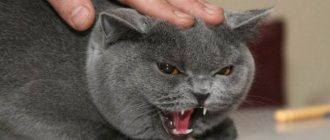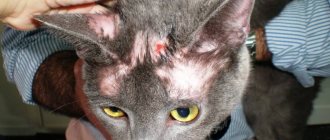Ears are considered one of the main organs of a cat. An animal's hearing is much better than a human's, but cats suffer from ailments of the auricle no less than people. Classification of ear diseases in cats:
- Diseases that appear as a result of damage to an organ by parasites.
- Infectious diseases.
- Diseases resulting from inflammation.
Many owners of pets are interested in the question of what ear diseases can occur in cats?
Ear diseases in cats: symptoms and treatment
Characteristics of ear diseases
Concha hematoma in cats
Appears against the background of received bites from other animals or blows. A bruise forms if the vessels of the auricle rupture. In this case, the area begins to fill with blood. Due to the pressure, the auditory organ swells for a few minutes after the rupture, causing a feeling of discomfort.
If proper treatment is not started at the first symptoms, the neoplasm remains, and subsequently the accumulated fluid passes into the scar tissue phase. This phenomenon can externally irreversibly change the organ of hearing. The size of the tumor depends on the pressure and the level of compliance of the tissues located near it. Hematomas occur on the inner plane of the ear and are much less common externally. Damaged ears increase in volume, droop; if you palpate, they are hot and painful. If the disease is left to chance, the pain increases, and bruising can lead to necrosis of the ear cartilage.
Concha hematoma in cats
Treatment consists of removing the hematoma with a syringe or surgery. You cannot do this on your own! After opening the hematoma, the doctor will prescribe a course of antibiotic such as Ampicillin.
Lymphatic extravasation of the ears in cats
It has similar symptoms and occurs for the same reasons as a hematoma. The only difference is in the method of therapy. When you are sick, applying cold or heat is harmful. If lymph accumulates, the liquid is also withdrawn with a syringe. When the procedure does not give a positive result, surgery is necessary. During the operation, the doctor trims the hair, treats an area of skin with an antiseptic, then cuts the skin, removes the contents and finally applies stitches. After the operation, antibiotics are also prescribed for 3-4 days.
Ear scabies in cats
Belong to the most common ailment. The disease is also called otodectosis, which is characterized by brown “islands” on the inside of the ear. They are similar in appearance to coffee. The disease is caused by ticks, which can be easily seen. It is necessary to carry out treatment in a timely manner so that there is no inflammation and the animal does not die.
Otodectosis of the ears
When the disease is advanced, the animal becomes apathetic, body temperature rises, and pathological conditions of the nervous system—convulsions—occur.
How to identify ear mites?
The tick looks like a red, brown parasite. The main signs of the parasite include twitching of the ears, turning the head from side to side, bad odor from the ear, and the presence of clusters of brown color. The animal will scratch its ears, so wounds may appear in this area. In this case, a veterinarian will help the pet owner. The doctor will determine the disease, clarify the diagnosis, and prescribe therapy. Self-medication will only harm your cat's health, but there is one option that can be used for treatment at home.
How to treat otodectosis at home?
The procedure for treating ear mites does not require special knowledge and skills, so everything can be done at home. But when we talk about “advanced cases,” it is best to contact a veterinarian straight away.
How to carry out treatment? Be sure to clean the ear of crusts and pus before using medications. Use hydrogen peroxide or Chlorhexidine applied to a cotton swab. To clean the ear, you can take cotton swabs that are moistened with alcohol. The procedure is repeated 1-2 times a day. Only after the cat’s ears have been treated with alcohol or peroxide can the medicine be used as prescribed by a veterinarian.
Treatment consists of cleaning the ear with a cotton swab containing medication. Before visiting a doctor, it is permissible to use an effective long-acting product against fleas, lice, ticks and other skin parasites. Before instilling drops of “Bars”, “Tactic”, “Amit”, “Frontline Spot-on”, “Acaromectin” or “Otoferonol”, you need to clean your ears from old crusts. Additionally, “Stronghold” drops are added to the withers.
Otoferonol drops
Important! Bars drops for treating ticks are especially effective. They must be applied to the skin in the neck area to prevent the animal from licking it off.
Video - Otodectosis in cats
Otitis in cats
Otitis is characterized by inflammation. The symptoms resemble the same signs as in the case of ticks. These are redness, high levels of wax in the ears, irritation. scratch its ears so often . The disease should only be treated by a veterinarian, since complications may occur if the treatment is improper. The pet owner must take the cat to a veterinarian and follow the doctor's recommendations.
Treatment consists of treating the ear with Chlorhexidine and removing wax using an exudate solution. After removing all the crusts, the ear is instilled with Otipax, Sofradex or Anandin Plus .
Otipax drops
Neoplasms in the auricle
Neoplasms appear more often in older animals in the area covering the ear canal. Such growths are considered benign. However, an ulcerated bleeding tumor in the external auditory canal is difficult to treat, and the animal is often euthanized. Tumors look like small nodules in which an infectious process occurs. The doctor may order a collection of cells or tissues (biopsy) for diagnostic purposes. In some cases, benign growths can be treated with surgery, but not in an advanced stage.
Treatment involves prescribing a course of antibiotics and corticosteroids. Additionally, there are painkillers like Motrin or Advil.
Painkiller Motrin
Eczema or dermatitis of the ear
This problem refers to inflammation of the outer ear. The factor of the disease is considered to be the entry of a foreign body into the organ, the penetration of liquid. The pet feels unpleasant irritation. The skin swells and turns red. A dark-colored discharge with an unpleasant odor is noticeable in the area. The animal holds its head on its side.
In this case, you can remove the foreign body from the ear using a syringe with three percent hydrogen peroxide. Wet areas are treated with astringents, such as a 2% silver solution, 3-5% solution of picric or boric acid. In case of severe itching, Cordiozol is used and corticosteroid ointments such as Hydrocortisone and Geocorton are prescribed.
But in any case, it is better to consult a doctor who will rinse the ear and prescribe the necessary medicine.
Inflammatory processes
Let's consider inflammatory processes in the ear and their types. With otitis media, inflammation occurs in the ear. There are 3 types:
- external;
- middle;
- interior.
Treatment of otitis media in cats at home
All types differ from each other in the prerequisites for their occurrence. In addition, it should be noted that there is a variation of the disease: the outer and inner ear.
External inflammation. With this type, the first step is to exclude infection with parasites, especially ticks. With external inflammation of the ear, swelling, redness, and severe irritation appear, causing the cat to try to scratch the area with its claws. When the disease is detected very late, the animal’s hair may fall out and pus may ooze from the affected area. There are several factors for contracting this type of disease:
- as a result of injury or splinter;
- when the animal is hypothermic;
- the disease may appear as a result of an infectious process caused by pathogenic microorganisms or viruses;
- due to fungus;
- accumulation of wax in the ear;
- allergy.
Streptococci and staphylococci can provoke inflammatory processes in the ears of animals
Inflammatory damage to the auditory tube, which causes deterioration in the ventilation of the tympanic cavity with the formation of otitis media. This type of illness is rare. It may appear as a complication of external inflammation if the therapy was carried out incorrectly. The cause of the appearance may also be an injury.
Reference! The initiators of the disease are often streptococci and staphylococci. The disease occurs with purulent discharge in an acute form.
Streptococci and staphylococci can provoke inflammatory processes in the ears of animals
Signs and treatment
The severe consequences of inflammatory processes are manifested by lifelong pathology of coordination, the animal loses hearing. The signs of the disease are as follows:
- the cat refuses to eat, tilts its head in the direction affected by the disease;
- swelling is noticeable;
- increased body temperature;
- acute purulent discharge;
- the animal walks hesitantly.
Does your cat refuse to eat? She's probably unwell
Inflammation of the inner ear appears against the background of complications of previous types of ear disease. The pathology process is severe, with pronounced symptoms:
- hearing loss;
- problems with the direction of body movement;
- lack of appetite;
- when palpating the temples, pain occurs.
A long course of antibiotics is prescribed as treatment. This may be a series of cephalosporins for 25-30 days with further adjustment of therapy in accordance with the results of bacteriological studies. In case of relapse, surgical treatment or drainage of the ear cavity is often used.
When hot ears are the norm
The ears of mammals, including cats, serve as the main part of the body that participates in heat exchange, so that the body does not overheat.
Hot ears themselves are a normal condition if the temperature does not exceed certain limits, which are defined as follows:
- in kittens up to +39.6 o C;
- in adult cats up to +39.0 o C;
- up to +42.4 o C.
Before determining how hot the ears and nose should be for a particular breed, you need to read its description, because each species has its own indicators.
In addition, there are several factors that objectively increase body temperature:
- after physical activity of the animal - for example, after playing with a cat;
- immediately after waking up, cats’ ears are also somewhat hotter than usual, and besides, the nose is dry in the first minutes - this is also a physiological norm;
- due to the established hot weather in the summer;
- due to the fact that the cat slept on the floor, as a result of which one of its ears cooled down, and the temperature of the second, on the contrary, increased;
- in a stressed state, the temperature of the body as a whole, including the ears, rises by several tenths of a degree, which is quite normal.
Thus, if an increase in the temperature of the cat’s ears and head is observed irregularly, as a result of explainable reasons, such conditions are normal, so there is no need to fear for the health of the animal.
Symptoms of ear diseases
Whatever the disease, the animal always shows some symptoms with which the doctor can make a diagnosis. Therefore, when it comes to ear diseases, veterinarians identify several main signs of illness.
- Tilt of the head to the side.
- The pet regularly tries to scratch its ears because it is tormented.
- The cat is apathetic.
- Any ear disease is characterized by discharge from the auditory organs.
- The pet often presses its ears to its head.
- The temperature rises.
- The auricle is red, and fluid accumulation may be noticeable on its surface.
Symptoms of ear diseases in cats
The main thing at the first changes in the cat’s well-being is to visit a veterinarian, who can immediately identify the cause and prescribe competent therapy.
Hematomas and abscesses
Both of these ailments are the result of trauma to the animal. In general, their symptoms are similar, as are the reasons why they appear in a cat. Often, without proper treatment, a hematoma can develop into an abscess.
Cats that are let outside by their owners often suffer mechanical damage to the ear. This can be especially observed with the onset of spring, when cats fight for the attention of cats, or simply do not divide the territory. The pet returns home with various injuries, both open wounds and bruises.
A hematoma is a closed type injury, simply a bruise. As we know, it appears from various blows. Just like a person, the bruised area hurts a lot. Most often, cats' ears are susceptible to hematomas, so it is quite easy to see a bruise, since the animal has less hair on them.
If your pet is acting restless, screaming and pressing its ear, carefully examine it. Often he won't even let you touch him. This is a clear reason to see a doctor.
An abscess is a consequence of an open injury, purulent inflammation. Any scratch can lead to an abscess. Ears are damaged during fights; cats often injure them with each other's claws. Since they always contain dirt, sand or dust, they get into the wound. After your cat has visited the street, you must carefully examine him for scratches and carefully treat the wounds on his ears with disinfectants. If this is not done, the injury site may swell, turn red and fester. Here you can handle it yourself, if the affected area is small, treat it with iodine and disinfect it. But it's better to show it to a doctor. The veterinarian will open the abscess on the animal's ear and remove the pus.
Treatment
Let's consider how to treat ear diseases in cats? The first step is to get rid of the hair around the ear and from the inside. The wool is cut and treated with 3% hydrogen peroxide. These are all measures that a cat owner can personally take at home. The main treatment is prescribed by a veterinarian. How and with what to treat a cat depends on the doctor’s opinion.
If ear inflammation is caused by bacteria, drugs in the form of drops are used. These drops contain an antibiotic. When a cat's ear disease is associated with infection by parasites, medications against insects and ticks must be prescribed.
Only a veterinarian can prescribe the correct treatment
When an animal has allergies, it is necessary to use pharmaceuticals that relieve irritation and inflammation. In some cases, you may need to administer antibiotics in the form of injections or oral administration.
If there is a hematoma, it is necessary to puncture it with a needle to allow the blood to come out. This way you can prevent further accumulation of pus. Then the damaged area is washed by injecting an antibiotic into the cavity. Certain ear diseases are treated exclusively surgically, for example, in the case of a sudden narrowing of the ear canal resulting from prolonged inflammation.
Attention! When instilling drops, you must ensure that they are evenly distributed along the inner plane of the auricle. Then the ear is pressed against the skin and massaged a little.
Today, there are many substances available to treat ear mites in cats. Substances are divided into three types:
- preparations in the form of drops and powder;
- aerosols and ointments;
- injection.
Video - How to put drops in a cat's ear?
Prevention of ear disease
Prevention of ear problems includes cleaning with substances prescribed by your veterinarian. This type of cleaning must be carried out continuously. Do not forget that the process of cleaning the ears should not cause pain to the animal. The entire procedure is done carefully so as not to injure the cat’s hearing organs. To avoid any unpleasant moments, you need to know what the prevention of ear disease in cats is. To clean your ears you need to:
- prepare tools, substances;
- will make sure that the cat is calm and not alarmed;
- wrap the animal in a towel to protect yourself from scratching with claws;
- It is necessary to drop a substance or lotion into the ear;
- after instillation, you should not pinch your ear too much and make massaging movements;
- After this manipulation, you can take a cotton swab and remove excess liquid.
When the treatment and cleaning of the ear is done correctly, the cat owner does not need to worry that the pet may develop complications. Teach your animal from childhood to constant ear examinations. Do this delicately, combining it with gentle stroking.
It is necessary to periodically prevent ear diseases
Ear washing lotions - “Otifri” and “Epi-otik”, as well as “Bars” lotion, in addition to 2 products from the German company Beaphar - can be obtained at any veterinary store. An interesting solution is the “Miss Kiss” sticks - these are ordinary sticks soaked in a medicinal agent.











